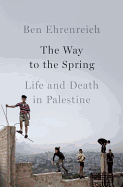
Ben Ehrenreich's The Way to the Spring: Life and Death in Palestine is a work of journalism written with the lyrical passion of a novelist. For his first nonfiction book, Ehrenreich (The Suitors) spent three years embedded with Palestinian families living in the West Bank. "I do not aspire in these pages to objectivity," he writes, instead invoking "something more modest than objectivity, which is truth." The Way to the Spring is unapologetically on the side of the Palestinian people, marshalling facts, history, anecdote and personal experience in order to persuade the reader to the author's point of view. That does not mean, however, that Ehrenreich's book is interested only in proving rhetorical points. The Way to the Spring functions primarily as an extraordinary love letter to a people that persist.
Ehrenreich has a good eye for the absurdities that emerge under occupation. In one example, he depicts a Palestinian house that was in the path of a wall being built between Israeli and Palestinian sectors. The owner refused to move, and Israeli authorities responded by building both the wall and fencing that left the family "caged in and cut off from the rest of the village."
We get only a peek into the settlers' worldview, however, because Ehrenreich's goal is not objectivity and he doesn't attempt to give anything like equal time. Instead, he analyzes the current situation as seen through Palestinian eyes: the complicated history that leads to the current moment, the hidden mechanisms of subjugation and the vast reserves of hope and bravery that insure the Palestinian people will continue marching to the spring. --Hank Stephenson, bookseller, Flyleaf Books

